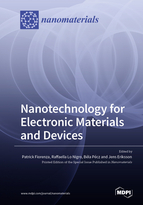Nanotechnology for Electronic Materials and Devices
A special issue of Nanomaterials (ISSN 2079-4991). This special issue belongs to the section "Nanoelectronics, Nanosensors and Devices".
Deadline for manuscript submissions: closed (15 May 2022) | Viewed by 33596
Special Issue Editors
Interests: nanoscaled and nanostructured materials; wide band gap semiconductor; nanoscaled heterostructures; advanced nanoscale characterization techniques; advanced semiconductors
Interests: atomic layer deposition; dielectrics; thin films; oxides; nitrides; chemical vapor deposition; power devices; wide band gap semiconductors
Special Issue Information
Dear Colleagues,
Among the principal goals of the International Roadmap for Devices and Systems, the historical scaling down of electronic devices is now coupled with the need for novel nanomaterials and emerging characterization and fabrication techniques focused on interaction at the nanoscale. Nanomaterials for electronic devices are of growing interest, since their reduced dimensionality can be associated with unique properties which are currently finding rapid application in many technological areas (such as high-frequency electronics, power devices, displays, energy conversion systems, energy storage, photovoltaics, and sensors). On the other hand, the accurate characterization of materials and interfaces at the nanoscale, along with standard metrics and protocols, is crucial for moving from research to technology development in the field and for quality control of innovative products and functionalities.
This Special Issue will cover the most recent developments on nanomaterials and nanotechnologies for electronic devices and sensors, from synthesis to advanced characterization, up to device fabrication.
Specific topics covered by the issue are:
- Nanoscaled material and their properties: nanostructured thin films (oxides, nitrides), nanocomposites, nanoparticles, and 2D materials (graphene or MX2 M = Mo, W, etc. and X = S, Se, Te, etc.);
- Synthesis techniques for nanomaterials and thin films: processes and novel approaches;
- Advanced nanoscale characterization techniques (surface analytical and scanning-probe methods, electron beam methods, optical methods, X-ray methods);
- Applications of nanostructured materials and nanotechnologies to electronic devices (high frequency and power devices, photovoltaics, sensors, etc.).
Full research papers, communications, and reviews are all welcome.
Dr. Patrick Fiorenza
Dr. Raffaella Lo Nigro
Dr. Béla Pécz
Dr. Jens Eriksson
Guest Editors
Manuscript Submission Information
Manuscripts should be submitted online at www.mdpi.com by registering and logging in to this website. Once you are registered, click here to go to the submission form. Manuscripts can be submitted until the deadline. All submissions that pass pre-check are peer-reviewed. Accepted papers will be published continuously in the journal (as soon as accepted) and will be listed together on the special issue website. Research articles, review articles as well as short communications are invited. For planned papers, a title and short abstract (about 100 words) can be sent to the Editorial Office for announcement on this website.
Submitted manuscripts should not have been published previously, nor be under consideration for publication elsewhere (except conference proceedings papers). All manuscripts are thoroughly refereed through a single-blind peer-review process. A guide for authors and other relevant information for submission of manuscripts is available on the Instructions for Authors page. Nanomaterials is an international peer-reviewed open access semimonthly journal published by MDPI.
Please visit the Instructions for Authors page before submitting a manuscript. The Article Processing Charge (APC) for publication in this open access journal is 2900 CHF (Swiss Francs). Submitted papers should be well formatted and use good English. Authors may use MDPI's English editing service prior to publication or during author revisions.








